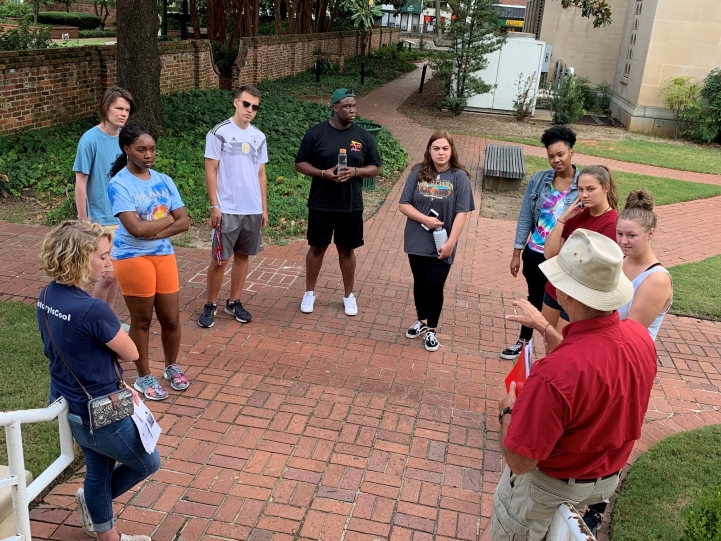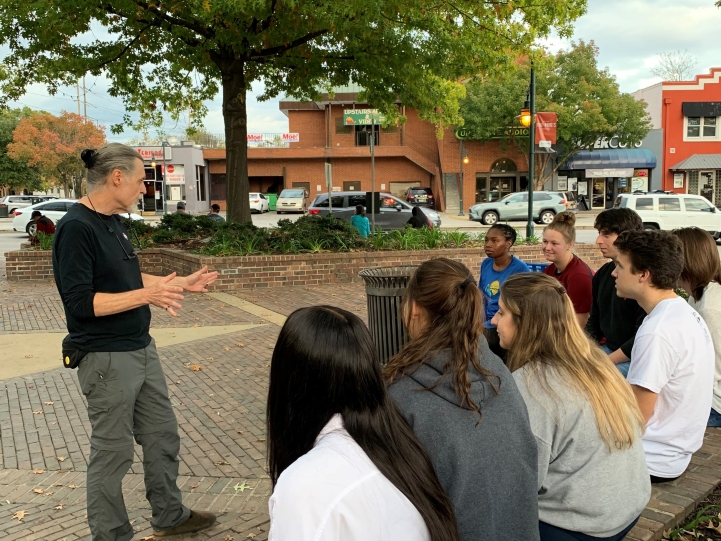Strengthening External Relations in the Classroom
Student Affairs Fundraising and Communications
January 10, 2020
This fall, the College of Arts and Sciences and the Office of Off-Campus Living and Neighborhood Relations at the University of South Carolina launched a new course: COLA 298: Community-Centered Leadership and Innovation. COLA 298, as it is known to the students enrolled, is designed to equip students with the theoretical foundations for solving the complex issues shared by both the university and local community. The course provides an overview of the shared history and relationship between the university and community, specialized training and skill development for analyzing and solving complex social issues, and most uniquely, an opportunity to work directly with community partners throughout the semester to apply these strategies. While the course seeks to provide students with a multi-disciplinary approach to leading social change, this course also provides an opportunity to strengthen relationships between the university and external community partners.
In March 2019, the University of Virginia’s Thriving Cities Lab published the “Field Guide for Urban University-Community Partnerships.” The field guide provides an overview of 100 urban universities across the country, highlighting innovative practices and identifying new directions for university-community partnerships. According to the guide, 90% of surveyed universities have course offerings engaging students with learning centered around the local community (Yates & Accardi). These courses are typically designed to support student success, better preparing individuals for life after college, as active citizens in their communities. The field guide notes that while these courses can be organized in a variety of ways, the majority of courses involve a service-learning component (Yates & Accardi).
With community-centered pedagogy being one of the most widely implemented practices of enhancing town and gown relationships – why not try to enhance these initiatives, while still supporting student learning? As mentioned, a majority of courses engaging students with the community involve a service-learning component, where students often go into the community to learn. While service-learning is a valuable opportunity for students and community members, there may be additional ways in which students can engage with local issues alongside community members that not be best categorized as service-learning.
 Rather than students going into the community to learn, COLA 298 explores this area by bringing the community into the classroom. The COLA 298 course has 3 course goals: 1) help students understand the university’s role as a significant part of the local community, 2) foster creative and innovative ideas and approaches to social problems, and 3) prepare students for applying effective strategies for creating social change and innovation. The first goal is achieved by providing students with a contextualized understanding of the relationship between the university and greater community. Supplemented with reading assignments, this semester’s class went on a walking tour with Historic Columbia, a local organization dedicated to preservation, education, and advocacy. Historic Columbia designed a custom tour for our class that took students from campus, through a surrounding neighborhood, and ended at a local entertainment district. University Hill, the nearby neighborhood, is designated as a historically significant neighborhood and shared an incredible amount of history with the university. This activity provided students with a strong understanding of the historical context that greatly impacts the current state of relations between the university and surrounding communities.
Rather than students going into the community to learn, COLA 298 explores this area by bringing the community into the classroom. The COLA 298 course has 3 course goals: 1) help students understand the university’s role as a significant part of the local community, 2) foster creative and innovative ideas and approaches to social problems, and 3) prepare students for applying effective strategies for creating social change and innovation. The first goal is achieved by providing students with a contextualized understanding of the relationship between the university and greater community. Supplemented with reading assignments, this semester’s class went on a walking tour with Historic Columbia, a local organization dedicated to preservation, education, and advocacy. Historic Columbia designed a custom tour for our class that took students from campus, through a surrounding neighborhood, and ended at a local entertainment district. University Hill, the nearby neighborhood, is designated as a historically significant neighborhood and shared an incredible amount of history with the university. This activity provided students with a strong understanding of the historical context that greatly impacts the current state of relations between the university and surrounding communities.
This course is designed to have a different topic related to community and university relations each semester. This semester, students are working on 3 different projects related to Five Points, the primary entertainment district for students. Over the past few years, there have been growing concerns related to high-risk behavior and safety of patrons in the district. Additionally, retail and dining businesses have been struggling in the district, leaving the area with many vacant store-fronts, furthering the narrative that the district serves simply as a ‘bar district’ rather than a community village, as it had in the past. These concerns have been brought forth by the university, local business owners, community leaders, and the neighborhoods surrounding Five Points. While these entities have been engaging with one another to make improvements, one obvious group was not being engaged in the discussion: students.
Glen E. Martin, a criminal justice reform advocate, says that “those closest to the problem are closest to the solution.” If the more than 30,000 undergraduate students were to blame for some of the high-risk behavior taking place in the Five Points district, why not ask them how to improve the district? While they may not be experts in local ordinances or small business practices, they are certainly subject matter experts on what attracts patrons to the district as well as how some high-risk behavior may be mitigated.
With these issues in mind, students themed their 3 projects under one theme: making Five Points a 24/7 destination. That is, how can the entertainment district do more to attract a variety of patrons to the area, especially during the day, shifting the narrative that Five Points is simply a late-night spot for college students. To work towards this goal, students focused on 3 projects: improving pedestrian friendliness in the area, enhancing the community and cultural scene of the area, and doing market research on attracting patrons to the area during the day. Throughout the semester, these groups have been meeting with local business owners, members of the Five Points Association, the Carolina Community Coalition, and local leaders to brainstorm ideas for their proposals to make improvements for the area. At the end of the course, these projects will be presented to Five Points stakeholders and members of the university and local community in hopes their perspectives will further efforts by community leaders to improve Five Points for everyone.
While the topic will change each semester, there are significant ways in which this course has strengthened relationships between the university and surrounding community. Below are 3 key considerations for implementing or enhancing similar initiatives:
- Centering students in external relations. While institutions prioritize students in their work, students are often left out of the conversation when considering their positive contributions to strengthening relationships. Even when students may be a driving force for strained relationships, it is vital to pull students into the conversation to tap into their unique expertise.
- Tapping into mutual interests. Partnerships should be rooted in equity, serving the interests and success of all involved. Both stakeholders of Five Points and students want the entertainment district to thrive. Acknowledging mutual interests allow everyone involved to work with a common purpose, reducing opportunities to discount opinions and perspectives.
- Building trust. To many external community members, the university can be a daunting place to navigate. This class served as an opportunity to bring community members into the university, providing time and interactions to build trust between the two entities. Further, in the capacity of this course, students and community members could have honest dialogue, building trust through active engagement with one another towards a common goal.
 As universities and communities look to the future of thriving town and gown relationships, it will be increasingly important to think creatively and innovatively to adapt to the changing characteristics of higher education. For some institutions, community engagement may be at the heart of their mission, for others, it will soon need to be. As leaders seek to enhance external relations at their institution, the COLA 298 course concept can serve, in some ways, as a petri dish for the university and community. The course engages students directly with community partners, working together to find creative and innovative solutions for local issues. Over time, these positive symbiotic interactions will strengthen the relationships between the institutions and the communities in which they exist.
As universities and communities look to the future of thriving town and gown relationships, it will be increasingly important to think creatively and innovatively to adapt to the changing characteristics of higher education. For some institutions, community engagement may be at the heart of their mission, for others, it will soon need to be. As leaders seek to enhance external relations at their institution, the COLA 298 course concept can serve, in some ways, as a petri dish for the university and community. The course engages students directly with community partners, working together to find creative and innovative solutions for local issues. Over time, these positive symbiotic interactions will strengthen the relationships between the institutions and the communities in which they exist.